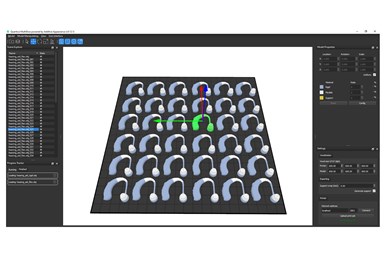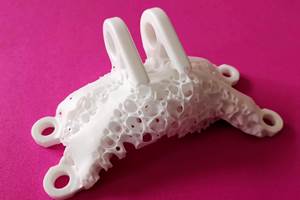Quantica Adds AI-based MultiSlice Software to Multimaterial 3D Printing System
The software offers a reliable simulation of 3D models for printing, providing a straightforward pathway to accurately manufacture multimaterial end products.
Quantica has added AI-based MultiSlice software to its NovoJet Open printhead technology to enable the reliable simulation of 3D models for multimaterial 3D printing. With NovoJet Open technology, it is users can combine functional materials on a voxel level to produce final parts in a single printing process.
For this reason, Berlin-based Quantica collaborated with Additive Appearance (a Charles University spin-off company) to offer a software solution that addresses the challenge of seamlessly combining multiple materials, which is a critical aspect when designing any application with specific requirements on properties.
Offering a reliable simulation of 3D models for printing, the software provides a straightforward pathway to accurately manufacture multimaterial end products.
MultiSlice: From Shape to Appearance and Function
The MultiSlice build management and slicing software combined with the NovoJet Open printing system enables users to produce objects that go beyond mere shape replication. Additionally, this includes replicating both appearance and function. Harnessing the potential of simulations and drawing on the distinctive expertise of computer graphics researchers in the mathematics and physics department at Charles University, the software utilizes advanced algorithms to predict the appearance of a 3D model with a high level of accuracy.
MultiSlice will be introduced with the first NovoJet Open systems early 2024. The two teams plan to develop the technology in multiple iterations toward different levels of sophistication with regard to the control of physical properties on a voxel level. These will include mechanical properties like flexibility and conductivity, appearance properties like color, and the ability to transition between them.
“Both our companies, embodying the agility of startups, are uniting to redefine the potential of 3D material jetting. In a landscape where functional, multimaterial 3D printing lacks adequate software, we are excited to collaborate with a team that is leveraging modern approaches to developing complex software,” says Grace Chang, Quantica’s head of product management. “Our collaborative goal is to leverage these advancements, making functional, multimaterial 3D printing more accessible, efficient and adaptable.”
Leveraging the potential of artificial intelligence (AI) and the technology it is based upon — differentiable programming — the team at Additive Appearance has created novel approaches to enduring problems in the printing industry such as halftoning and print preview. Following years of academic research, they have published multiple scientific papers in top-tier journals. One publication is presenting an approximative but faster print preview using a neural network. In concurrent work, a halftoning method based on differentiable programming is described.
“With the trend in 3D printing going to more and more printheads, existing software is starting to limit the hardware’s potential. The problem of which material to put in which voxel is getting increasingly difficult,” says Tobias Rittig, Ph.D., Additive Appearance’s chief technology officer. “This is why a radically new approach based on cutting-edge research and modern software technologies, such as differentiable computation and machine learning, is required to drive the printers of the future. We both share this realization and are looking to create a synergy of software and hardware that unlocks many new possibilities in the material jetting domain.”
Quantica says its NovoJet technology transforms high-viscosity materials into multimaterial end-use parts, delivering high-performance prints with exceptional properties in a single process.
- Listen to this episode of AM Radio to hear about Quantica’s 3D printing jetting head at RAPID + TCT 2022. Editors Stephanie Hendrixson, Peter Zelinski and Julia Hider share observations, insights and photos from the 2022 RAPID + TCT trade show.
Related Content
Ultimaker 5.0 Cura Enables Finer, Faster Prints
The software’s enhanced slicing engine is said to enable thinner walls and finer details in additive manufacturing.
Read MoreTo Scale Additive Manufacturing, Separate Design and Production
Spokbee’s online marketplace is designed to ease the launch and sale of customizable, 3D printed products. Its flexibility comes from cloud-based CAD and a distributed network of service bureaus for production.
Read MoreSpherene Creates Metamaterial with Geometry Derived from Spheres
An algorithm developed by Spherene Inc. generates Adaptive Density Minimal Surfaces (ADMS) as a self-supporting infill strategy that can be used to reduce mass and manage material properties in 3D printed parts.
Read MoreImplicit Modeling for Additive Manufacturing
Some software tools now use this modeling strategy as opposed to explicit methods of representing geometry. Here’s how it works, and why it matters for additive manufacturing.
Read MoreRead Next
Hybrid Additive Manufacturing Machine Tools Continue to Make Gains (Includes Video)
The hybrid machine tool is an idea that continues to advance. Two important developments of recent years expand the possibilities for this platform.
Read More4 Ways the Education and Training Challenge Is Different for Additive Manufacturing
The advance of additive manufacturing means we need more professionals educated in AM technology.
Read More3D Printing Brings Sustainability, Accessibility to Glass Manufacturing
Australian startup Maple Glass Printing has developed a process for extruding glass into artwork, lab implements and architectural elements. Along the way, the company has also found more efficient ways of recycling this material.
Read More























